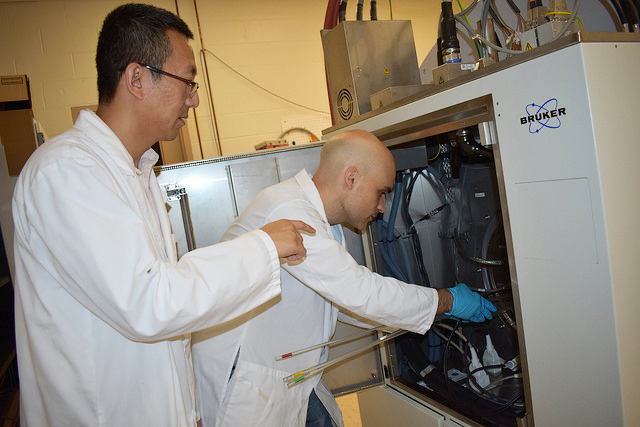
Nanyin Zhang and Pablo Perez, postdoctoral fellow, run the MRI scanner. IMAGE: PENN STATE
Zhang and other researchers receive $3.7 million grant to further national BRAIN initiatives
9/28/2018
UNIVERSITY PARK, Pa. — Two Penn State professors are collaborating to bring real-world solutions to better understand neuroimaging signal through the support of a $3.7 million National Institutes of Health (NIH) Brain Research through Advancing Innovative Neurotechnologies (BRAIN) Initiative grant focusing on resting state functional magnetic resonance imaging (fMRI).
This NIH grant will allow the two researchers — Nanyin Zhang, professor of biomedical and electrical engineering; and Patrick Drew, associate professor of engineering science and mechanics, neurosurgery and biomedical engineering; both serving as co-principal investigators — to take a deeper look into the resting state fMRI technique, which measures connectivity between brain regions. In addition, they will team up with Xiao Liu, assistant professor of biomedical engineering, on signal analysis.
The goal of the research is to uncover the neural basis of resting state fMRI signal using multiple approaches in awake rats, including multi-echo fMRI, MR-compatible calcium signal recording, optogenetics and multi-laminar electrophysiology. The resting state fMRI technique is a powerful and non-invasive tool to combat diseases such as Alzheimer’s, traumatic brain injury and epilepsy. However, what types of neural activity resting state fMRI actually measures remains poorly understood. Zhang has been conducting research to answer this question.
“The brain has many types of neurons. We are looking to see how activities of different types of neurons contribute to the resting state fMRI signal,” said Zhang. “We will develop new techniques that integrate cutting-edge neuroscience tools with fMRI to achieve that goal.”
“Understanding how the activity of different classes of neurons controls cerebral blood flow is a fundamental biological problem, but the answer has immediate utility for interpreting functional MRI scans in humans,” said Drew.
This NIH grant has three components: resting state fMRI, optogenetics and electrophysiology. The combination of these methods offers unprecedented capacity to unveil the neural basis of resting state fMRI signal.
Zhang’s laboratory will manipulate neural activity using optogenetics, and measure calcium as well as resting state fMRI signals, while Drew’s laboratory will participate in the electrophysiological methods. Liu will contribute to the computational side of the research.
“I personally believe that this grant will bring the biomedical imaging research at Penn State to a new level. Results from this grant will have immediate impact on the interpretation of human resting state fMRI data. They will also be instrumental in resting state fMRI studies in disease in the future.” said Zhang.
Zhang and Drew have also received $2.3 million from NIH for a separate project to determine how the communication between neurons and cerebral blood vessels changes from post-natal development into adulthood.



